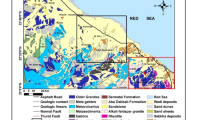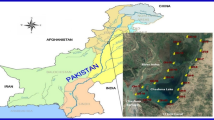Abstract
Doce River suffered major environmental impacts throughout their courses due to the disruption of the tailings dam of the company Samarco—Brazil, characterizing it as the biggest accident in the mineral area throughout the southern hemisphere. The radiometric signature obtained for natural radionuclides of occurrence in sediment is an indicator of radiological pollution caused by accidents. By means of gamma-ray spectrometry, this work determined the radioactivity levels in sediments from samples collected before (2014) and after (2015) the accident obtaining indicators of pollution radiometric, namely radium equivalent, external and internal radiological risk, and compare them with the reference levels.

Similar content being viewed by others
References
Jones D (2004) The relative importance of physical, chemical and biological processes in the Irish sea. Earthwise Issue 21. British Geological Survey. NERC 2004
Giglio VJ, Freitas MO (2013) Caracterização da pesca artesanal com rede de camboa na reserva extrativista de Cassurubá-BA. Bitemas 26(2):249–259
Pereira MD, Siegle E, Miranda LB, Schettini CAF (2010) Hidrodinâmica e Transporte da Material Particulado em Suspensão em um Estuário dominado por Maré: Estuário Caravelas (BA). Rev Bras Geof 28(3):427–444
INSTITUTO CHICO MENDES DA BIODIVERSIDADE (ICMBio) (2017) Relatório Consolidado da Pluma do Rio Doce após Rompimento da Barragem de Mariana-MG, Universidade Federal do Espírito Santo (UFES), p 254
Agência Nacional de Águas (ANA) (2015) Monitoramento Especial da Bacia do Rio Doce - Relatórios 1&2, 2015
Davis J (2004) Naturally occurring radioactive materials. Earthwise Issue 21. British Geological Survey. NERC, 2004
Wang J, Liu J, Chen Y, Song G, Chen D, Xiao T, Wu S, Chen F, Yin M (2016) Technologically elevated natural radioactivity and assessment of dose to workers around a granitic uranium deposit area, China. J Radioanl Nucl Chem 310:733–741
Spacov ICG (2016) Monitoração de trabalhadores expostos à radiação natural em minas no seridó do nordeste brasileiro. Tese de Doutorado. UFPE—Universidade Federal de Pernambuco, Recife
United Nations Scientific Committee on the Effects of Atomic Radiation (UNSCEAR) (1996) In: Forty-second Session of UNSCEAR, United Nations, New York. A/AC 82/R 526
Suresh S, Joshi VM, Jha SK, Tripathi RM (2017) Distribution of uranium in sediment of creek ecosystem. J. Radioanl Nucl Chem 313:79–83
Carmo RF (2018) Avaliação dos níveis de radioatividade natural e do risco radiológico na foz do Rio Doce antes e depois do rompimento da barragem de Fundão. Tese de Doutorado. IRD, Rio de Janeiro
Chechev VP et al. (2011) Table of radionuclides (Vol. 6—A = 22 to 242). Monographie BIPM-5, Sèvres, p.85-89
Souza PS, Clain AF, Trindade Filho OL, Oliveira EM, Delgado JU, Lopes RT (2019) Production of spiked vegetation samples containing γ-emitting radionuclides for proficiency testing. JRNC 321(3):851–856
Boshkova T, Minev L (2001) Corrections for self-attenuation in gamma-ray spectroscopy of bulk samples. Appl Radiat Isot 54:777–783. https://doi.org/10.1016/S0969-8043(00)00319-5
Cutshall NH, Larsen ILE, Olsen CR (1983) Direct analysis of 210Pb in sediment samples: self-absorption corrections. Nucl Instrum Methods 206:309–312
GENIE-2000 (2013) Spectroscopy Software Customization Tools. Canberra Industries, USA
Carneiro PFP, Filho JA, Silva CM (2009) Environmental Radioactivity on Suape Estuary: Impact of the Installation of Oil Refinary. International Nuclear Atlantic Conference—INAC 2009
Dlugosz-lisiecka M, Bem H (2013) Fast procedure for self-absorption correction for low γ energy radionuclide 210Pb determination in solid environmental samples. J Radioanal Nucl Chem 298:495–499
Beretka J, Mathew PJ (1985) Natural radioactivity of Australian building materials, industrial wastes and by-product. Health Phys 48:87–95
Medhat ME (2009) Assessment of radiation hazards due to natural radioactivity in some building materials used in Egyptian. Radiat Protect Dosim 133:177–185
Organization for Economic Cooperation and Development (OECD) (1979) Exposure to radiation from natural radioactivity in building materials. Report by a Group of Experts of the OECD Nuclear Energy Agency, OECD, Paris
Ademola JA (2008) Determination of natural radionuclides content in some building materials in Nigeria by gamma-ray spectrometry. Health Phys 94:43–48
Hassan NM, Ishikawa T, Hosoda M, Sorimachi A, Tokonami S, Fukushi M, Sahoo SK (2010) Assessment of the natural radioactivity using two techniques for the measurement of radionuclide concentration in building materials used in Japan. J Radioanal Nucl Chem 283:15–21
United Nations Scientific Committee no the Effects of Atomic Radiation (UNSCEAR) (1977) Report to the general assembly with annexes
Krieger R (1981) Radioactivity of construction materials. Betonwerk Fertigteil Tech 7:468–473
International Commission on Radiological Protection (ICRP) (1977) Recommendations of the ICRP. ICRP Publication 26. Ann. ICRP 1(3)
Sapucaia NS, Argollo RM, Barbosa JSF (2005) Teores de potássio, urânio, tório e taxa de produção de calor radiogênico no embasamento adjacente às bacias sedimentares de Camamu e Almada, Bahia, Brasil. Rev Bras Geof 23(4):453–475
Al-hamameh IF, Awadallah MI (2009) Soil radioactivity levels and radiation hazard assessment in the highlands of northern Jordan. Radiat Meas 44:102–110
Kurnaz A, Kücükömeroglu B, Keser R, Okumosoglu NT, Korkmaz F, Kaharan G, Çevik U (2007) Determination of radioactivity levels and hazards of soils and sediment samples in Firtina Valley (Rize, Turkey). Appl Radiat Isot 65:1281–1289
Almayahi BA, Tajuddin AA, Jaafar AA (2012) Effect of the natural radioactivity concentrations and 226Ra/238U disequilibrium on cancer diseases in Penang, Malaysia. Radiat Phys Chem 81:1547–1558
Ravisankar R, Sivakumar S, Chandrakaran A, Jebakumar JPP, Vijayalakshami I, Vijayagopal P, Venkatraman B (2014) Spatial distribution of gamma radioactivity levels and radiological hazard indices in the East Coastal sediments of Tamilnadu, India with statistical approach. Radiat Phys Chem 103:89–98
Al-trabulsy HA, Khater AEM, Habbani FI (2011) Radioactivity levels and radiological hazard indices at the Saudi coastline of the Gulf Aqaba. Radiat Phys Chem 80:343–348
Ravisankar R, Chandramohan J, Chandrasekaran A, Jebakumar J, Vijayalakshmi I, Vijayagopal P, Venkatraman B (2015) Assessments of radioactivity concentration of natural radionuclides and radiological hazard indices in sediment samples from the East coast of Tamilnadu, India with statistical approach. Mar Pollut Bull 97(1–2):419–430. https://doi.org/10.1016/j.marpolbul.2015.05.058
Yang Y, Wu X, Jiang Z, Wang W, Lu J, Lin J, Wang L, Hsia Y (2005) Radioactivity concentrations in soils of the Xiazhuang granite area China. Appl Radiat Isot 63:255–259
Author information
Authors and Affiliations
Corresponding author
Ethics declarations
Conflict of interest
The authors declare that they have no conflict of interest.
Additional information
Publisher's Note
Springer Nature remains neutral with regard to jurisdictional claims in published maps and institutional affiliations.
Rights and permissions
About this article
Cite this article
Carmo, R.F., Filho, O.L.T., Delgado, J.U. et al. Radiometric signature as an indicator of radiological pollution on Rio Doce after the disaster in tailings dam. J Radioanal Nucl Chem 323, 741–747 (2020). https://doi.org/10.1007/s10967-019-07009-3
Received:
Published:
Issue Date:
DOI: https://doi.org/10.1007/s10967-019-07009-3




